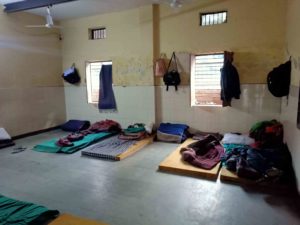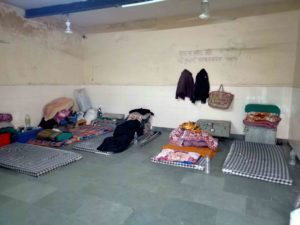Patriot visits some night shelters to check the living conditions of the homeless people in the Capital city as Covid demands more space between beds
A global pandemic, homelessness and disability — the three make a deadly combination. As Delhi has entered into the chilly winter and temperatures are going down, touching three-degree Celsius, Delhi’s night shelter homes are a difficult sight to look at.
In a grimy room, as many 12 disabled men were competing for space in a night shelter for the disabled located near Delhi gate. In fact, when you compare night shelters, this was far better than the others located in different parts of the city.
For Praveen, a painter hailing from UP, night shelter is home as it is free but gives him the company of friends along with whom he stays here. He lost his legs in an accident two years ago and now works as a daily wager. During the day he goes out for work and spends the nights in a shelter home.
A similar situation prevails for Sailendra, a waste picker from Bihar. “Since Covid, getting work is tough, many a time we spend even our days here. We don’t face many problems. We are provided with a blanket, doctors check us from time to time.”

At Delhi Gate and Munirka, night shelter frequenters didn’t complain much. However, in night shelters in the Nizamuddin area and one near Lodhi Road that we visited, people complained about blankets not being warm enough. Mohan, a daily wager said, “it is fine during the day but nights are tough, as even the thicker blanket provided doesn’t keep us warm.”
Most importantly, masks are rare to find at these shelter homes. People sitting unmasked around fires, near open drainage, are common sights near many night shelters. Homeless people are used to taking shelter in these night shelters every winter but during a pandemic this looks more worrying.
“We tell them to wear masks, some comply and some don’t. We can’t force everyone,” said Vikky Sharma, caretaker at a night shelter near Delhi Gate.
Sarai Kale Khan night shelter complex near the Metro station has six night shelters including makeshift tents, all packed with around 400 people in close proximity.
Due to the Covid-19 induced lockdown, many labourers are back home in their respective villages. However, night shelters are increasingly seeing people coming and staying there. Anjula Khatoon, caretaker for a night shelter at Munirka, said that during winter, numbers increase but this time around many labourers have gone home. So their number has declined.
This increase in the number of homeless people coming to shelter homes in the winter season was expected. And Delhi Urban Shelter Improvement Board (DUSIB) has built some new permanent and temporary buildings keeping the demand in mind.
Despite that the revised capacity adhering to social distancing norms (six feet), there is demand for 7,945 beds. The original capacity is 19,861 which is well below the number of homeless people in Delhi as per DUSIB estimations, which means more than 60% people are spending nights in open streets or footpaths.
In a report titled ‘rapid assessment of the homeless population’ conducted in 2014, DUSIB estimated the number of homeless persons in the city to be 16,760. However, the Census of India 2011 suggests that there are 47,076 homeless persons in Delhi and independent estimates suggest that this number can be up to 2 lakh.
The data suggests that in the national capital, a lot of people are spending their night under the open sky. Even during this pandemic and chilly winter.
A study by Centre for Policy Research states that DUSIB reserves 18 square feet of space per resident, while as per the National Urban Livelihoods Mission (NULM), 50 square feet is the requirement for the shelter for homeless.

Dr Indu Prakash Singh, a member of the Supreme Court-appointed shelter monitoring committee in Delhi said that DUSIB owes money to Society for Promotion of Youth and Masses, (SPYM), an agency that manages the majority of night shelters in Delhi. “Payments, like for food, are due from March-April and these shelter homes are providing food. How will they arrange?”
On delayed payment, an official at DUSIB told us on condition of anonymity that “Payment is due because of late submission of bills by managing agencies.”
On Wednesday, Delhi Urban Development Minister Satyendar Jain issued directives to the officials of DUSIB to enhance the existing facilities available in the night shelters — like availability of hot water, evening tea and to increase the number of toilets.





